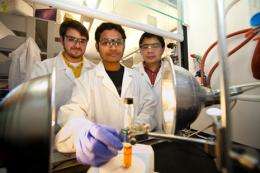Chemists harvest light to create 'green' tool for pharmaceuticals

(�鶹��ԺOrg.com) -- A team of University of Arkansas researchers, including an Honors College undergraduate student, has created a new, "green" method for developing medicines. The researchers used energy from an ordinary 13-watt compact fluorescent light bulb to create an organic molecule that may be useful in the treatment of Alzheimer’s and other brain diseases. The finding, coauthored by Soumitra Maity, Mingzhao Zhu, Ryan Spencer Shinabery and Nan Zheng, is published in the current issue of Angewandte Chemie International Edition.
“Our chemical reaction provides a new structure, a new building block for pharmaceutical companies that has not been available before,” said Zheng, an assistant professor of chemistry in the J. William Fulbright College of Arts and Sciences who leads the team. “It’s a very unusual scaffold, very lipophilic and non-polar, which is what you need to cross the blood brain barrier.”
Visible-light photocatalysis, or chemical reactions sparked by visible light, are rare in organic chemistry, because most organic compounds can’t readily absorb visible light. Instead, organic chemists typically rely on ultraviolet, or UV light, which has disadvantages.
“UV lights heat up very fast and waste a lot of energy. You’ll also get a sunburn if your skin is exposed,” said Shinabery, a senior honors chemistry student.
Postdoctoral student Mingzhao Zhu initiated the research with his effort to use light from a cheap, readily available light source – a supermarket light bulb, in this case, although sunlight would work just as well – to make an organic molecule useful to chemists. Using ruthenium, a metal that is active in the presence of visible light, as a catalyst, Zhu produced an unexpected and unstable organic molecule. Shinabery subsequently worked to identify the structure of the molecule.
“Spencer was able to reproduce the result and help us understand how the molecule was formed, which we needed to design a new reaction,” Zheng said.
Maity, also a postdoctoral student, led the way in developing the new reaction, which is green thanks to efficiency as well as use of visible light.
“All of the atoms are converted to the product. There is no waste, no additives or co-catalysts, which makes the reaction very clean and atom economical,” Maity said. Maity also succeeded in crystallizing one of the products, in effect sketching out its three-dimensional structure, which is critical should it be further developed in pharmaceutical applications.
Zheng and Maity are currently working on a new, even more powerful result: the use of a catalyst with visible light to create a carbon-nitrogen bond, one of the most common and important bonds used in pharmaceuticals and materials.
“People thought carbon-nitrogen bonds couldn’t be formed this way; this will change people’s perception of visible light photochemistry,” Zheng said.
“I am working at all hours,” Maity added. “I lose track of time, because the work is so exciting.”
As for Shinabery, he is writing up his contribution to the finding as his senior honors thesis and weighing multiple offers from top graduate schools.
Journal information: Angewandte Chemie International Edition
Provided by University of Arkansas




















